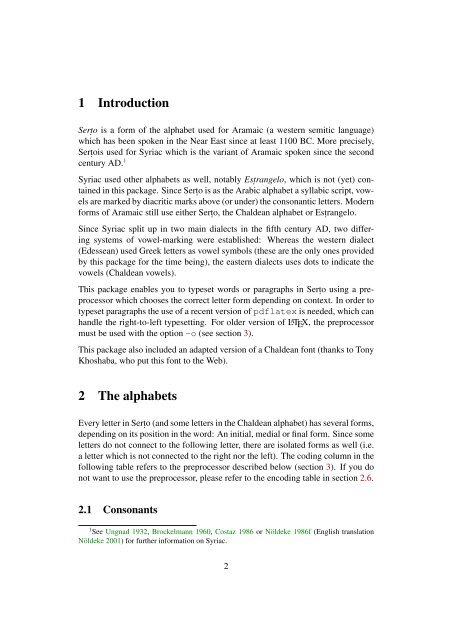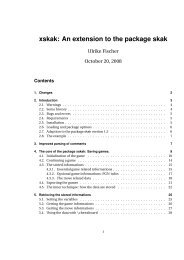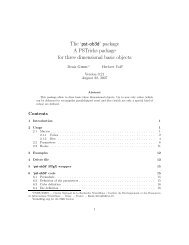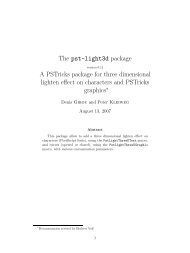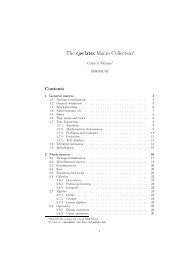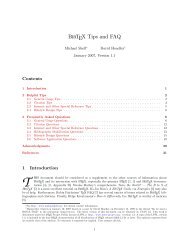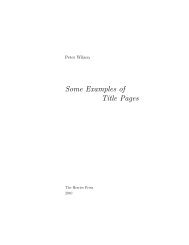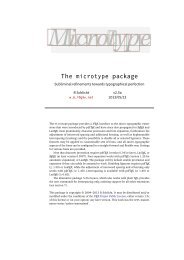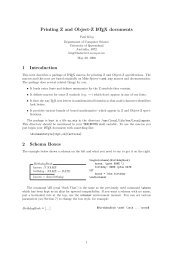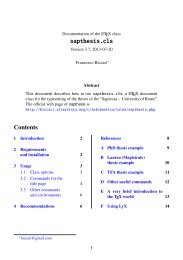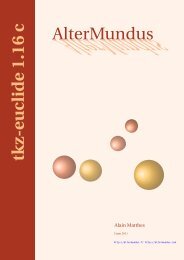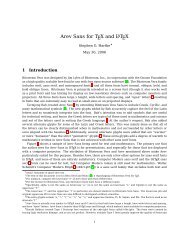Serto - A font for Syriac (Aramaic) - Johannes Heinecke
Serto - A font for Syriac (Aramaic) - Johannes Heinecke
Serto - A font for Syriac (Aramaic) - Johannes Heinecke
Create successful ePaper yourself
Turn your PDF publications into a flip-book with our unique Google optimized e-Paper software.
1 Introduction<br />
Serṭo is a <strong>for</strong>m of the alphabet used <strong>for</strong> <strong>Aramaic</strong> (a western semitic language)<br />
which has been spoken in the Near East since at least 1100 BC. More precisely,<br />
Serṭois used <strong>for</strong> <strong>Syriac</strong> which is the variant of <strong>Aramaic</strong> spoken since the second<br />
century AD. 1<br />
<strong>Syriac</strong> used other alphabets as well, notably Esṭrangelo, which is not (yet) contained<br />
in this package. Since Serṭo is as the Arabic alphabet a syllabic script, vowels<br />
are marked by diacritic marks above (or under) the consonantic letters. Modern<br />
<strong>for</strong>ms of <strong>Aramaic</strong> still use either Serṭo, the Chaldean alphabet or Esṭrangelo.<br />
Since <strong>Syriac</strong> split up in two main dialects in the fifth century AD, two differing<br />
systems of vowel-marking were established: Whereas the western dialect<br />
(Edessean) used Greek letters as vowel symbols (these are the only ones provided<br />
by this package <strong>for</strong> the time being), the eastern dialects uses dots to indicate the<br />
vowels (Chaldean vowels).<br />
This package enables you to typeset words or paragraphs in Serṭo using a preprocessor<br />
which chooses the correct letter <strong>for</strong>m depending on context. In order to<br />
typeset paragraphs the use of a recent version of pdflatex is needed, which can<br />
handle the right-to-left typesetting. For older version of L A TEX, the preprocessor<br />
must be used with the option -o (see section 3).<br />
This package also included an adapted version of a Chaldean <strong>font</strong> (thanks to Tony<br />
Khoshaba, who put this <strong>font</strong> to the Web).<br />
2 The alphabets<br />
Every letter in Serṭo (and some letters in the Chaldean alphabet) has several <strong>for</strong>ms,<br />
depending on its position in the word: An initial, medial or final <strong>for</strong>m. Since some<br />
letters do not connect to the following letter, there are isolated <strong>for</strong>ms as well (i.e.<br />
a letter which is not connected to the right nor the left). The coding column in the<br />
following table refers to the preprocessor described below (section 3). If you do<br />
not want to use the preprocessor, please refer to the encoding table in section 2.6.<br />
2.1 Consonants<br />
1 See Ungnad 1932, Brockelmann 1960, Costaz 1986 or Nöldeke 1986f (English translation<br />
Nöldeke 2001) <strong>for</strong> further in<strong>for</strong>mation on <strong>Syriac</strong>.<br />
2


